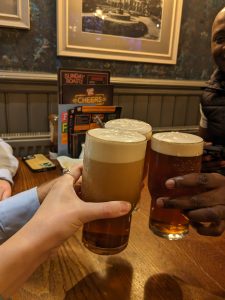January 6, 2025, by bbztlg
Ale as old as time: barley and the yeast
Researcher Christy Smith tell us the story of how human, plant and fungus have been collaborating for thousands of years to produce the perfect brew.
 The relationship between plants and fungi has spanned the ages of the earth. Ancient fungi manipulated rocks to create the soils that ancient plants needed to spread across the globe and produce the oxygen rich atmosphere ripe for animal life to flourish. After millions of years of plant-fungi teamwork, it was only around 300,000 years ago that humans evolved into this rich tapestry of interconnected life. Our species roamed Africa, exploring into the middle east and eventually spreading across the whole globe, hunting animals and gathering fruits and roots to survive.
The relationship between plants and fungi has spanned the ages of the earth. Ancient fungi manipulated rocks to create the soils that ancient plants needed to spread across the globe and produce the oxygen rich atmosphere ripe for animal life to flourish. After millions of years of plant-fungi teamwork, it was only around 300,000 years ago that humans evolved into this rich tapestry of interconnected life. Our species roamed Africa, exploring into the middle east and eventually spreading across the whole globe, hunting animals and gathering fruits and roots to survive.
This nomadic way of life suddenly changed around 10,000 years ago when humans began to interact with plants as they never had before. Rather than just picking and eating them, they started to select seeds from certain plants to replant and grow for future seasons. These wild plants belonged to the grass family and are known today as cereals. By only growing the more accessible and edible seeds from the wild plants, ancient humans transformed them into a more reliable source of food. Thus, hunter-gathers gradually became famers as people settled next to the cereals they were cultivating. Plant and human lived in symbiosis: the plants provided seeds for nutrition and the humans spread the seeds of the plants across the land, causing them to dominate the landscape. These seeds are known as grains.
But what about the fungus? Humble and often easily overlooked, living in soil, on fruits, tree sap and crucially, grains. One type of fungus in particular, yeast, digests sugars into CO2 and ethanol, a process known as fermentation. Ancient people that tried soaking their grains (perhaps to soften them), could return to find the water had changed colour, odour and had even started bubbling. Unbeknownst to these early brewers, the yeast on the grain had fermented the sugar in the grains and produced alcohol. Brave drinkers of this liquid would discover the pleasurable effects that a fermented drink has on the brain and how sharing these drinks can bring communities together to relax and have fun. There is archaeological evidence from around 7,000 years ago of special huts in ancient villages dedicated to preparing grains for fermentation. A process we now call ‘malting’.
 As well as grain, yeast can use sugar from other plants such as grapes, apples, potatoes, sugar cane and rice to produce the popular drinks of wine, cider, vodka, rum and sake, to name but a few. In each case, the fungus ferments the sugars from the plant with humans controlling, adjusting and capitalising the process.
As well as grain, yeast can use sugar from other plants such as grapes, apples, potatoes, sugar cane and rice to produce the popular drinks of wine, cider, vodka, rum and sake, to name but a few. In each case, the fungus ferments the sugars from the plant with humans controlling, adjusting and capitalising the process.
However, this seasoned collaboration is threatened as we consume more and more of the earth’s natural resources to produce food and drinks, without replenishing or protecting what is left. By altering the delicate balance of our complex ecosystems, we are experiencing unpredictable rainfall, drought, floods and changing sea levels. Amidst this unfolding global water crisis, the malting industry today requires 4-5,000 litres of water to produce each ton of malted grains. I am working in brewing science at the University of Nottingham on a project that aims to reduce the water footprint of malting and brewing. By searching for varieties of cereal that can be malted using less water; I am aiming to help plant breeders to develop new cereals that are even more water efficient.
The village-hut scale processes of malting and brewing have been transformed into giant industries over the course of human history, now the industry needs to evolve further to exist in balance with the natural resources that sustain them. I am so pleased to be part of the movement to safeguard the resources on the planet that have provided such a valuable human-fungus-plant partnership for so long. If we can protect the long-term health of this prehistoric trio then we can continue enjoy the delicious drinks they produce for millennia to come.
You can read more about Christy’s work in her interview with BARIToNE.
No comments yet, fill out a comment to be the first

Leave a Reply